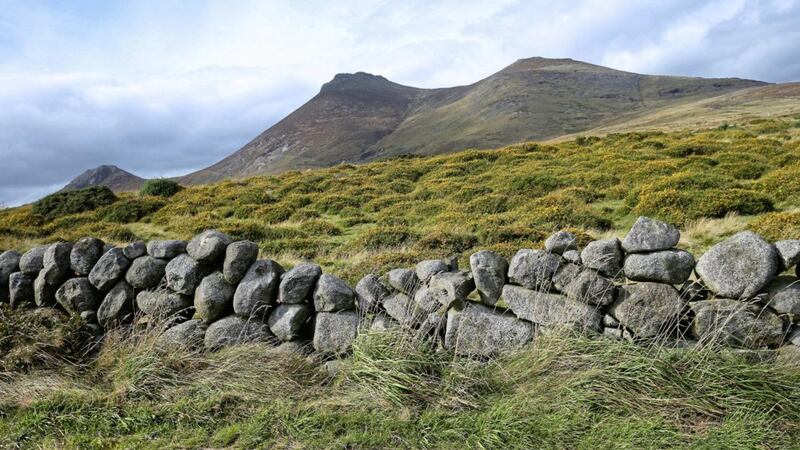WHEN the wind comes down off the mountain at a certain angle and catches in the gaps between the boulders in the dry-stone walls it make an other-worldly sound. It is a high-pitched whistle but with an underlying bass-note drone, as if someone is playing a tin whistle and a didgeridoo at the same time.
It is a unique musical backdrop that I have only ever heard in the Mourne Mountains, perhaps because of whatever techniques were used to build the walls – ditches as they are known in south Down.
These man-made structures can of course be seen throughout Ireland, but each region has its own technique and the ones in Mournes are distinctive.
The pathway that rises up through sheep-grazing fields is enclosed on either side by ditches and the wind comes in erratic gusts that will only occasionally be compressed through a gap among the stones to shriek its unnerving wail.
Through a gate and farmland and the wailing is left behind as I emerge into open ground with the mountains rising before me and to either side.
It has become a tradition each year to undertake this walk in early January, although tradition is too formal a word as it suggests something that is fixed or planned – but every year at about this time I find myself trekking up this familiar path.
The tailwinds of Storm Brendan are still swirling in the air and the morning is cold and damp, with flurries of rain building up into an angry frenzy before subsiding again. The ground is water clogged and rivulets are running off it towards where more permanent water channels have been carved.
The woodland, still recovering from summer fires which almost devastated it a few summer ago, is filled with the sound of starlings and the swish of wind through the trees. Two years ago I heard a cuckoo calling but there was not word of it any time I passed last year.
The path cuts across a fast-flowing river and now it is out into the mountains proper, rising steeper and more exposed to those icy fists of rain when they come.
The small hummock of mountain ahead is called Percy Byssche, apparently after the poet Percy Byssche Shelly (husband of Frankenstein author Mary Shelly) who is said to have briefly visited here in the early 1800s. Steep scars of rock make it popular with climbers using ropes and harnesses, but there is no-one else up here today.
The path meanders sharply upwards here before levelling out again and there is a brief pause as I consider going on up towards a ridge which over looks the Ben Crom reservoir.
But the clouds seem to be closing in and the sharp bursts of rain are becoming more frequent and sustained, so I duck in behind Percy Bysshe and along the shores of a small lough over which wavelets ripple to sit and eat an apple.
An earlier picnicker thoughtfully left their orange peels scattered on the shore for subsequent walkers to admire.
The path disappears here and I have to pick my way between the rocks and mountain heather and over boggy ground before descending again and looping back towards the track along which I came up.
Normally up here you can hear ravens making their distinctive crawing sound as they lumber through the air to their cliff-top nests, but they must be staying at home today.
Back down and clumsily treading my way over stepping-stones to cross two rivers and back past the forest towards where the land has been tended and a final chorus of that strange discordant whistle as the wind forces a path through the gaps in the stone walls.








